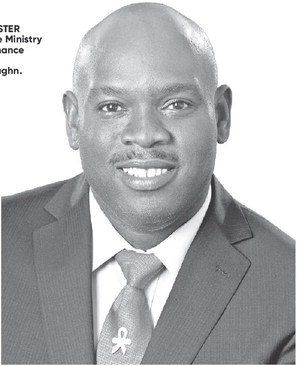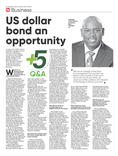US dollar bond an opportunity
In light of the US$1.6 billion deposited in foreign currency accounts in Barbados, Government has issued a new bond to raise US$100 million on the domestic market. Minister in the Ministry of Finance Ryan Straughn explained in an interview why the authorities have gone in this direction for the first time.
WHAT IS the thinking behind Government’s new bond offer to raise US$100 million?
After we did the debt restructuring, we had a fouryear grace period where we were only paying interest, and we resumed the payment of interest and amortisation, the principals, in October of 2022. That meant that we had to restart the domestic capital market, which we have done, I think, reasonably well with respect to issuance of not just treasury bills – three and six months – and we have a couple of one years, but also the BOSS + bonds, which have been five years at four and a half per cent.
In 2019, we liberalised the exchange controls and allowed Bajans to hold foreign currency accounts in the bank accounts in Barbados. What we have seen is a build up of US$1.6 billion in these accounts in our commercial banks and which are not earning any money, in the same way that Barbadian accounts in Barbados dollars are equally earning very little interest at all.
So, as we were looking in relation to the fact that, one, we were going to do the exposure in relation to the liability management on the external side, we recognised that there was an opportunity here whereby those persons who hold those foreign currency accounts would be able to participate.
So we issued the US$100 million bond over an 18-month period for three per cent to be able to allow those people to also invest, because you recognise it didn’t only make sense for people from the outside to invest, as they have done with this new US$500 million issuance that we just did, but also to get the Bajans who have foreign currency to invest.
Now, the critical thing here is that the US$100 million one is for 18 months only at just three per cent. Currently our 21-day treasury bill is 1.7 per cent, the BOSS bond at five years is about four and a half per cent and therefore the 18 months is just around there in that sweet spot, in order to be able to ensure that there is consistency with the interest rates that we are paying depending on the length of the specific maturity.
So we are trying to rebuild the yield curve to make sure that everything is consistent, so that there aren’t any specific outliers, and so as we improve the credit quality, we should expect certainly the yield curve to become not just more stable, but actually starts to normalise.
How does this US dollar bond fit into the overall debt and fiscal strategy?
When we introduced the corporate tax reform with respect to the global minimum tax, we also put the mechanism in place for the persons who the global minimum tax would apply to pre-pay on a monthly basis. In the past, those prepayments would normally be every quarter; we are now doing it every month for those persons. That was at the beginning of last year and from the beginning of this year, all companies for whom the nine per cent corporation tax applies in the rest of the economy, the pre-payment started from January and obviously small businesses don’t have to pre-pay. But the impact of that has meant that we have had to relook and reassess how regularly we issue Government securities, whether it’s treasury bills or other debt instruments.
And so, as part of the overall fiscal management, we are monitoring very carefully which debt we want to retire, because as the markets we will retire some of the more expensive debt, and retiring that debt might mean a swap, as we have done in the past couple of things with the multilateral development banks, but it also means being able to stretch out some of the maturities to smooth out the fiscal situation.
Why did you settle on an initial amount of US$100 million for the bond?
We thought it was important to provide an opportunity for Bajans directly, those who hold US dollars, to be able to also help finance the Government’s operations and the capital projects that are taking place.
When we did the non-deal road show, we did have an engagement with local and regional investors in addition to the international investors, in order to let them know what was happening in relation to the market.
We are making sure that we rebuild the yield curve and therefore it is an opportunity for Bajans as well to be able to invest in it. That US$1.6 billion is in the accounts of Bajans in the commercial banks, not counted as part of the reserves that we currently have at the Central Bank. So the ability for us to be able to attract some of that investment to drive growth domestically is also something that adds a little more resilience to Government’s debt strategy. And so it’s something that we were looking at for a while, and we want to be able to do it.
What response do you anticipate there will be to the US dollar denominated bond?
It is a little early, and I would imagine that in the same way that we saw significant response to the treasury bills, I anticipate that with a little more marketing and awareness and promotion, that persons will equally participate in that, because right now, the money is sitting in the banks and not earning anything.
We did an analysis of the flows and recognised that just like how Bajans have monies in their bank accounts and its just there, we observed similar patterns with respect to the foreign currency accounts. If it is at US$1.6 million and growing, then there is no rhyme or reason why we shouldn’t be able to see the subscription build over time.
So the thing is that it’s something that we have started, and we will look to see, obviously, how successful it is, in order to determine whether or not we need to go again, with respect to being able to attract that investment.
Will there also be opportunities for regional investors to invest in Barbados Government debt instruments?
We are looking at a regional bond as well, to be able to make sure that Barbados is a success story with respect to the reforms, that not just that it is told but people realise that Barbados is a safe investment.
We are also working on a regional debt swap mechanism with Inter-American Development Bank, CAF Development Bank of Latin America and the Caribbean, World Bank and Caribbean Development Bank to ensure that regional governments can execute debt swaps as we have.
And it’s not just the Caribbean, but also some countries in Latin America that are part of the Caribbean basin in order to make sure then that we have a clear structure so that the overall debt strategy is adequately executed.

‘
We did an analysis of the flows and recognised that just like how Bajans have monies in their bank accounts and its just there, we observed similar patterns with respect to the foreign currency accounts.
’


